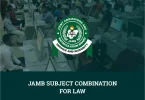The Joint Admissions and Matriculation Board (JAMB) has officially released the 2025/2026 Mathematics syllabus for the Unified Tertiary Matriculation Examination (UTME). The JAMB syllabus is a guide for students preparing to write Mathematics in the UTME and is meant to help candidates understand what topics to study and what skills they need to master. When writing Mathematics in JAMB, you do not need to memorize formulas; instead, focus on understanding the number concepts and applying them in real-life situations to solve the problem.
The JAMB syllabus for Mathematics is divided into five main sections, namely Number and Numeration, Algebra, Geometry, Trigonometry, and Calculus. Each section contains specific topics that every candidate must understand and be able to work with. This article will show you all you need to know about the JAMB syllabus for Mathematics, the aim of the syllabus, and other important tips to help you succeed in the UTME.
Objectives of the JAMB Syllabus for Mathematics
The syllabus aims to test students’ ability to calculate, think logically, analyze data, and apply mathematics to everyday problems. Using this syllabus, students are expected to:
- Build strong skills in basic calculations and mathematical operations.
- Learn how to think logically and reason clearly.
- Understand how to interpret graphs, charts, and tables.
- Use mathematical ideas to solve problems in real-life situations.
JAMB Syllabus for Mathematics 2025
Below is the breakdown of the JAMB syllabus for Mathematics and the topics students/candidates are expected to cover to study and understand to pass the JAMB UTME:
SECTION I: NUMBER AND NUMERATION
Number Bases
- Understand number systems from base 2 to 10.
- Learn how to convert numbers from one base to another, including decimals.
- Perform basic calculations and solve problems in modular arithmetic.
Fractions, Decimals, Approximations, and Percentages
- Do operations with fractions and decimals.
- Understand significant figures, decimal places, and how to calculate errors in percentages.
- Solve problems involving interest, profit/loss, ratios, proportions, and VAT.
Indices, Logarithms, and Surds
- Apply the laws of indices and solve related equations.
- Understand logarithms and how they relate to indices.
- Convert between logarithmic bases and work with surds (irrational roots).
Sets
- Learn the different types of sets and their properties.
- Use set symbols and Venn diagrams to solve problems involving 2 or 3 sets.
SECTION II: ALGEBRA
Polynomials
- Change the subject of a formula.
- Multiply, divide, and factorize polynomials up to degree 3.
- Apply the factor and remainder theorems.
- Solve linear and quadratic equations, and draw graphs of polynomials.
Variation
- Solve questions involving direct, inverse, joint, and partial variations.
- Calculate percentage increases or decreases in variation-related problems.
Inequalities
- Solve linear and quadratic inequalities both algebraically and graphically.
- Understand how to interpret inequality graphs.
SECTION III: GEOMETRY AND TRIGONOMETRY
Euclidean Geometry
- Properties of angles and lines
- Polygons (triangles, quadrilaterals, and general polygons)
- Circles (angle properties, cyclic quadrilaterals, and intersecting chords)
- Construction of geometrical figures.
Candidates should be able to identify various types of lines and angles, solve problems involving polygons, calculate angles using circle theorems, and identify construction procedures for special angles (e.g., 30°, 45°, 60°, 75°, 90°).
Mensuration
- Lengths and areas of plane geometrical figures
- Lengths of arcs and chords of a circle
- Perimeters and areas of sectors and segments of circles
- Surface areas and volumes of simple solids and composite figures
- The Earth as a sphere (longitudes and latitudes).
Candidates should be able to calculate the perimeters and areas of triangles, quadrilaterals, circles, and composite figures; determine lengths of arcs and chords; compute surface areas and volumes of solids; and understand the Earth’s geometry.
Loci
- Locus in 2 dimensions based on geometric principles relating to lines and curves.
Candidates should be able to describe and solve problems involving loci in two dimensions.
Coordinate Geometry
- Midpoint and gradient of a line segment
- Distance between two points
- Parallel and perpendicular lines
- Equations of straight lines.
Candidates should be able to calculate midpoints and gradients, determine distances between points, find equations of straight lines, and understand the relationships between parallel and perpendicular lines.
Trigonometry
- Trigonometric ratios of angles
- Angles of elevation and depression
- Bearings
- Areas and solutions of triangles
- Graphs of sine and cosine functions
- Sine and cosine formulae.
Candidates should be able to calculate trigonometric ratios, solve problems involving angles of elevation and depression, determine bearings, compute areas of triangles, and interpret sine and cosine graphs.
SECTION IV: CALCULUS
Differentiation
- Limit of a function
- Differentiation of explicit algebraic and simple trigonometric functions (sine, cosine, and tangent).
Candidates should be able to find the limit of a function and differentiate basic algebraic and trigonometric functions.
Application of Differentiation
- Rate of change
- Maxima and minima.
Candidates should be able to solve problems involving rates of change and determine maximum and minimum values using differentiation.
Integration
- Integration of explicit algebraic and simple trigonometric functions
- Area under the curve.
Candidates should be able to solve problems of integration involving algebraic and trigonometric functions and calculate areas under curves.
SECTION V: STATISTICS
Representation of Data
- Frequency distribution
- Histogram, bar chart, and pie chart.
Candidates should be able to identify and interpret frequency distribution tables and represent data using histograms, bar charts, and pie charts.
Measures of Location
- Mean, mode, and median of ungrouped and grouped data (simple cases only)
- Cumulative frequency.
Candidates should be able to calculate the mean, mode, and median of ungrouped and grouped data and use cumulative frequency to find the median, quartiles, and percentiles.
Measures of Dispersion
- Range, mean deviation, variance, and standard deviation.
Candidates should be able to calculate the range, mean deviation, variance, and standard deviation of ungrouped and grouped data.
Permutation and Combination
- Linear and circular arrangements
- Arrangements involving repeated objects.
Candidates should be able to solve simple problems involving permutations and combinations.
Probability
- Experimental probability (e.g., tossing a coin, throwing a dice)
- Addition and multiplication of probabilities (mutually exclusive and independent events).
Candidates should be able to solve simple problems in probability, including addition and multiplication rules.
Preparation Tips
Here are the preparation tips applicants are advised to follow to excel in the JAMB:
- Consistent practice helps reinforce concepts and improve problem-solving skills.
- Focus on understanding the ‘why’ behind mathematical principles, not just memorizing formulas.
- Solving past JAMB questions can familiarize you with the exam format and question types.
- Joining a study group can provide different perspectives and collaborative learning opportunities.
Conclusion
The JAMB Syllabus for Mathematics is a very important guide for all UTME candidates. It outlines what students need to focus on and the kinds of problems they should practice. Mastering these topics not only helps in passing the JAMB exam but also builds a strong foundation for future studies in any field that requires logical thinking and analytical skills. Ensure you go through the syllabus to understand the concepts, practice, and apply them in different ways. Use good textbooks and past questions. Bookmark this site for more updates and related posts!







Leave a Comment